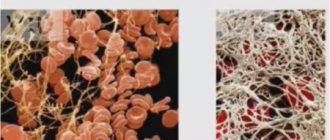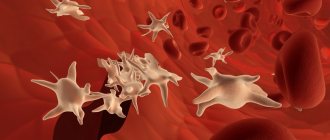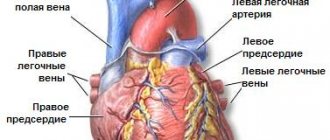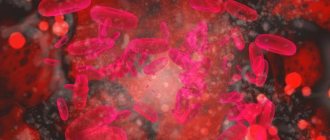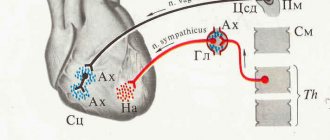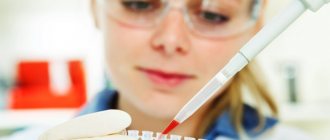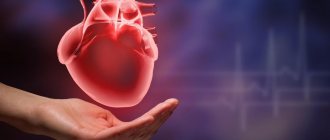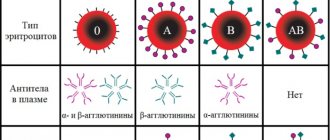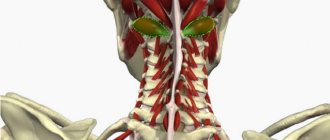What warm blood?
Our body temperature is fairly accurate at 36.6° C. Thus, equally warm (homeothermic) mammals and birds differ from the rest of the animal kingdom, where the external temperature determines the temperature inside the body. Fish, amphibians, reptiles and arthropods are active only at a certain ambient temperature.
Why is the blood warm?
- The blood is as warm as the body. The body temperature is 36.6° C, of which the blood temperature differs only on the surface and especially on the extremities.
- Body temperature is the result of many chemical reactions in an ectothermic organism - this means that the transformation of substances releases energy. To this is added heat-generating muscle work.
- Body temperature, which is maintained within narrow limits, is important for the function of numerous enzymes, gas exchange and osmotic processes.
- Blood is not only warm, but also important for the body's thermoregulation. It distributes the heat received inside the body and in the muscles evenly.
- Acute malnutrition, as well as excess blood and body temperature, are downright fatal. These include cooling or high temperature.
Don't be afraid of high temperatures
For many parents, even the words “high temperature” cause panic.
However, most often it is useful to the patient. Let's figure out exactly when a high temperature in a child or an adult is our friend, and when it is our enemy... To begin with, I will quote here the words of pediatrician N.P. Shabalov. (St. Petersburg) about fever in children:
“Fever is a protective-adaptive reaction of the body, expressed in the restructuring of thermoregulation to maintain a higher than normal level of heat content and body temperature. This is a typical process formed during the process of evolution in warm-blooded animals.
Fever is created by the body itself, its regulatory systems...
The biological expediency of fever as a process is explained by the acceleration of catabolism (decay) of the “foreign” at the site of inflammation (proven for pneumococci, gonococci, spirochetes, and high fever - above 40 degrees is simply destructive for these microbes, phagocytosis and immunity are activated).
The use of antipyretics is inappropriate, since they “obscure” the clinical picture of the disease, providing a sense of false security. Antipyretic therapy carries risks - side effects of drugs in the form of allergic reactions, inhibition of the hematopoietic sprout of the bone marrow, damage to the gastric mucosa..."
Academician G.I. Marchuk showed that elevated temperature accelerates the migration of lymphocytes and viruses, they more often collide with each other and form “virus-lymphocyte” complexes, and an artificial decrease in temperature using tablets can provoke protracted or chronic diseases.
I will quote a few more fragments from Robert Mendelsohn “How to Raise a Healthy Child in Spite of... Doctors”:
Fact No. 7. Most cases of fever are associated with viral and bacterial infections, which the body's defenses cope with without any help. Colds and flu are the most common causes of fever. The temperature may rise to 40.5 degrees, but even then there is no cause for concern.
The only danger is the risk of dehydration from the accompanying processes of sweating, rapid pulse and breathing, coughing, vomiting and diarrhea. It can be avoided by giving plenty of fluids. It would be nice if the child drank a glass of liquid, preferably nutritious, every hour. This could be fruit juice, tea, or anything that the child won’t refuse.
Fact No. 9. The temperature caused by a viral or bacterial infection, if not brought down, will not rise above 41 degrees. Pediatricians do a disservice by prescribing antipyretics.
As a result of their prescriptions, parents' anxiety that the temperature may rise to the extreme limit if measures are not taken is reinforced and intensified.
Doctors do not say that lowering the temperature does not affect the healing process, nor does it say that the human body has a mechanism (not yet fully explained) that does not allow the temperature to overcome the barrier of 41 degrees.
Fact No. 10. Measures to reduce temperature, be it the use of antipyretics or wiping with water, are not only unnecessary, but also harmful.
If a child is infected, then the increase in temperature that accompanies the course of the disease should be perceived by parents not as a curse, but as a blessing. The temperature rises as a result of the spontaneous production of pyrogens - substances that cause fever.
This is the body's natural defense against disease. An increase in temperature indicates that the body's healing system is up and running.
A quick guide to temperature from the same book:
Fever is a common symptom in children that is not associated with serious illness (in the absence of other alarming symptoms such as unusual appearance and behavior, difficulty breathing and loss of consciousness). It is not an indicator of the severity of the disease. The temperature that rises as a result of infection does not reach values at which irreversible damage to the child’s organs is possible.
Fever does not require medical intervention beyond what is recommended below. There is no need to lower the temperature . It is the body's natural defense against infection and helps speed up healing.
1. If a child's body temperature rises above 37.7 degrees under two months, consult a doctor. This may be a symptom of an infection - intrauterine or associated with interference in the birth process. Fever in children of this age is so unusual that it is prudent to play it safe and calm down quickly if the alarm turns out to be false.
2.
For children older than two months, a doctor is not needed if the temperature rises, except in cases where the temperature lasts more than three days or is accompanied by serious symptoms - vomiting, difficulty breathing, severe cough for several days and others not characteristic of a cold. Check with your doctor if your child is unusually lethargic, irritable, distracted, or appears seriously ill.
3. Contact your doctor regardless of the thermometer reading if your child has difficulty breathing, is vomiting uncontrollably, if the temperature is accompanied by involuntary muscle twitching or other strange movements, or if there is anything else bothering you about your child's behavior or appearance.
4. If a rise in temperature is accompanied by chills, do not try to cope with this feeling in your child with a blanket. This will lead to an even sharper increase in temperature. Chills are not dangerous - this is a normal reaction of the body, a mechanism of adaptation to higher temperatures. It does not mean that the child is cold.
5. Try to put a feverish child to bed, but don't overdo it. There is no need to chain your child to a bed and keep him indoors unless the weather is too bad. Fresh air and moderate activity will improve your baby's mood without worsening the condition, and will make your life easier. However, too intense exercise and sports should not be encouraged.
6. If there is reason to suspect that the cause of the high temperature is not an infection, but other circumstances - overheating or poisoning, take the child to the hospital immediately. If there is no emergency room in your area, use whatever medical care is available.
7. Do not try, according to popular tradition, to “starve out a fever.” Nutrition is important for recovery from any illness. If the child does not resist, “feed” both colds and fevers.
Both of them burn the reserves of proteins, fats and carbohydrates in the body, and they need to be replaced. If your child refuses to eat, give him nutritious liquids, such as fruit juice.
And don't forget that chicken soup is good for everyone.
High fever and the symptoms that usually accompany it lead to significant fluid loss and cause dehydration . It can be avoided by giving the child a lot to drink, fruit juices are best, but if he doesn’t want them, any liquid will do, preferably one glass every hour.
And finally, how can one not remember Hippocrates, who said, “Give me a fever and I will cure any disease!”
Well, now a few conclusions and personal experience. Why is there a dogma in my head that the temperature NEEDS to be brought down? Yes, simply because in addition to doctors who prescribe tons of antipyretics, there are also our mothers and grandmothers, who themselves were raised on antipyretics and raised us in the same way.
They also like to scare us with stories about blood clotting at 42 degrees and the presence of convulsions in children at high temperatures. It is worth noting here that febrile seizures NOT life-threatening.
If the WHO is an indicator for someone, then it mentions that cramps are not the result of high temperature, but the result of a jump in temperature .
That is, they can begin either from a sharp rise in temperature or from a sharp decrease (often thanks to antipyretics).
The funny thing is that their fear by pushing medicine not into themselves... but into the child ! And, of course, after this, illness for the child is guaranteed.
The use of antipyretic drugs is justified only for children with severe pathologies of the nervous system, epilepsy, congenital heart defects... The excessive use of antipyretic, anti-inflammatory, antibacterial drugs, and immunomodulators has led to the fact that today we have a lot of “frequently ill children.” Parents “heal” their children, forgetting about the body’s natural defense mechanisms.
It is also worth remembering the Slavs, who invented the bathhouse specifically for heating (!!!) the body. For some reason, our ancestors knew that heating the body is useful for illnesses, but we forgot about it. Why?
Yes, simply because it is a business . If parents understand that antipyretic syrups and tablets do not provide the desired recovery, then what will happen to the pharmaceutical companies? That is why bright and colorful advertising brochures tell us how to get rid of high fever. All this advertising was created by experienced psychologists - you need to understand this.
Currently, treatment of children with Nurofen . This drug is widely advertised as an effective and safe antipyretic and analgesic.
“However, there have been cases when Nurofen caused a sharp drop in temperature to subnormal numbers (34-35 degrees), which was accompanied by a life-threatening collapse - a sharp drop in pressure.
This is especially dangerous for children who have intoxication caused by infection, as well as for children suffering from disorders of the conduction system of the heart (which parents are not always aware of) and intracranial hypertension.
Serious complications, including death, are possible, not only in infants, but also in children of primary school age...”
You can also mention the “exploits” of paracetamol - also a favorite drug by many.
“Having analyzed data from more than two hundred thousand children (not the first study of this kind with similar results), we had to recognize a serious correlation between the development of childhood asthma and the use of paracetamol. Moreover, the more you consumed, the more likely asthma, rhinoconjunctivitis and eczema were...”
And, of course, aspirin . The “FLU Institute” recommends avoiding the use of aspirin. “Because with virus B, unlike virus A, aspirin causes a neurological syndrome (Reye's syndrome) with enlarged liver.
In addition, when the virus enters the human body, blood vessels dilate and blood clotting increases, which is how aspirin works.
In fact, doubling the effect can cause very serious undesirable consequences..."
I really want to convey to people the following:
1) By lowering the temperature even by half a degree, we do not allow the body to develop specific immunity, and the next time it encounters this infection, it will again be helpless before it.
2) The body will still try to “take over” and carry out the program, that is, we lower the temperature, the body raises it again - thus, the healing process is delayed longer than if we had not interfered with it.
3) All help is an intervention, but not all intervention is help.
4) Dehydration occurs not from temperature, but from loss of fluid, which must be replenished. When the time comes, the temperature will calmly drop on its own.
5) High temperature during infection, cold, food poisoning... is a survival mechanism.
6) You should respect the reactions of your body, treat it like an intelligent, capable of everything, a close friend striving for healing, and it will respond with health. A person who goes through an acute illness correctly never have chronic illnesses.
7) Currants, raspberries, honey, rose hips, drinking are good, but in no case are pharmaceutical poisons imposed on us from television screens.
Source – “Dak”
Irina Drutsa, October 20, 2011
Source: //via-midgard.com/news/in_midgard/15478-ne-bojtes-vysokoj-temperatury.html
Where the blood heats up
While reptiles and insects must wait for the sun to reach operating temperature, mammals and birds obtain their temperature primarily from two processes: from chemical reactions within the body and the release of energy through muscle work .
Chemical reactions in the body are rarely endothermic, that is, only when heat is applied. Many processes that only occur at high temperatures are made possible by enzymes. These proteins reduce the activation energy of chemical reactions so that they already take place at body temperature.
Many of these metabolic processes release energy in the form of heat, so they are exothermic. The same applies to muscle activity, which produces a lot of heat - this is known from sweating during sports and physical activity.
Why is it so important to maintain body temperature?
Our entire metabolism is geared toward a body temperature of 36.6° C. This is especially true for enzymes, which can only perform their reactions primarily within a narrow temperature range optimally. Likewise, the musculoskeletal system works best at this temperature.
Another important factor is gas exchange. The absorption and release of oxygen and carbon dioxide in the body's tissues and lungs are optimized for body temperature. Likewise, temperature influences the osmotic behavior of particles, for example in the kidney.
Particularly important is the increase in temperature above 40° C: here many proteins begin to denature. This is the main reason why high fever is fatal.
Why does blood clot during a general blood test?
Blood clotting is an important indicator of human health.
If the degree of coagulation is normal, blood circulates evenly throughout the body, supplying the organs with oxygen and nutrients, and any small open injury or damage to the epidermis heals quickly. If the plasma is too thick or thin, a person risks a number of serious diseases - potentially life-threatening.
Norm and deviations
In order to determine blood clotting indicators in a particular person, it is necessary to conduct a laboratory analysis of biological material. In a normal state, the density of blood is concentrated at 1048-1066 units, and the density of the plasma in the composition is also important. Its normal values are 1029 – 1034. Arterial blood is less dense than venous blood.
The viscosity itself depends on the ratio of proteins and red blood cells in the liquid tissue. In cases with deviations, several scenarios are possible - the blood becomes too thick or too thin.
Thrombophilia is a bleeding disorder with excessive plasma density, along with blood cells.
The disease is dangerous because it increases the risk of blood clots; a person is susceptible to diseases such as thrombosis or varicose veins.
If deviations are not controlled, the risk of strokes and heart attacks increases, and the load on the liver and kidneys increases, causing chronic problems with these organs.
A deviation in which the blood is too thin is called hypocoagulation; it can threaten a person with large blood loss with minimal trauma or damage.
Causes of increased blood clotting
The composition of human blood always remains unchanged, but the ratio of components constantly fluctuates throughout life. This is influenced by many factors.
What affects blood clotting in adults:
- increased levels of red blood cells and platelets due to disease;
- high hemoglobin levels;
- dehydration or poor fluid absorption;
- insufficient amount of enzymes;
- large blood loss due to open injuries to the epidermis or damage to internal organs;
- frequent consumption of foods containing large amounts of sugar and carbohydrates;
- constant being in a stressful state;
- radiation exposure.
The cause of hypercoagulation is old age, hereditary pathologies, certain medications, as well as diseases that cause the formation of fibrinogen in quantities significantly higher than normal.
Specifically speaking, the reasons for increased blood clotting may include the following abnormalities:
- infectious diseases;
- hepatitis, liver cirrhosis;
- hormonal imbalances;
- atherosclerosis;
- thrombophilia, varicose veins;
- diabetes;
- weakened immune system;
- pancreatitis;
- development of benign or malignant neoplasms;
- genetic pathologies;
- hypoxia, constant surges in blood pressure;
- myeloma;
- hemophilia, von Willebrand disease.
The high-risk group consists of people who lead a passive, sedentary lifestyle - bedridden patients, as well as pregnant women, since their body is undergoing serious hormonal changes. All of the above leads to increased blood thickening.
Symptoms of hypercoagulability
It is quite difficult to detect high blood clotting during a normal lifestyle without visiting doctors. The disease can remain undetected for a long period of time, making itself felt only when there is too little time left before the development of a vascular catastrophe.
The first signal for immediate examination may be a situation when a person scratches the skin, but blood does not ooze from the wound - the process of blood clotting begins almost instantly.
Hypercoagulation is also evidenced by the difficulty of collecting biomaterial in a medical laboratory - after puncturing the skin and vascular wall, the plasma literally coagulates at the tip of the needle, making it impossible for blood to enter the syringe.
Other indicators of hypercoagulation may include general ailments:
- constant feeling of fatigue, weakness;
- drowsiness;
- frequent headaches;
- diseases of the gastrointestinal tract and internal organs that do not receive enough nutrients;
- manifestation of spider veins on the surface of the legs;
- feeling of heaviness in the legs in the evening.
If one or more symptoms are detected, you must immediately contact a qualified specialist who will examine your blood cells for the presence of pathologies and prescribe a series of medical examinations.
If you ignore the violations and do not prescribe the correct course of treatment in a timely manner, blood clots may form in the blood supply, leading to the sudden death of a person.
What is the danger of the disease?
Blood thickening and blockage of blood vessels in the circulatory system can lead to thrombosis and the following life-threatening tragedies:
- myocardial infarction;
- venous or arterial thrombosis of the extremities;
- ischemic stroke;
- infarction of internal organs such as kidneys, lungs, intestines.
Also, disturbances in blood viscosity often cause tissue necrosis, hypertension, cerebral hemorrhages, and atherosclerosis.
All of these diseases can cause loss of capacity, not excluding death.
Diagnosis of disorders
In order to determine the density and composition, it is necessary to take blood clotting tests. In case of serious deviations, the problem will become obvious immediately, since the blood clots quickly and collecting material is difficult.
In the absence of obvious violations, the laboratory analyzes the plasma and the protein it contains. Determination of blood clotting time is carried out manually - a drop of material is placed under a microscope, and a specialist records changes in the composition using continuous observation and a stopwatch.
Also, when making a diagnosis, anamnesis is important - the doctor must be aware of the diseases the patient has suffered and surgical interventions. Diseases that affect his immediate family or the presence of pregnancy when it comes to a woman are no exception.
The study of hemostasis with diagnosis is impossible without determining the level of platelets and a detailed analysis of other plasma components, such as fibrinogen, alpha, beta, gamma globulins.
Increased blood clotting during pregnancy
Girls carrying a baby must pay special attention to the thickness and composition of their blood; the supply of nutrients to the fetus and its development depend on this. Plasma viscosity during pregnancy begins to increase from the 12th week of pregnancy and continues until the third trimester.
This is due to an increase in factors affecting the general condition of the body: hormonal changes, changes in metabolism, pressure surges, etc.
Also, the process is natural and provided for by nature, because if the blood were too liquid, during childbirth the pregnant woman would die from severe, uncontrollable blood loss.
Pregnancy should be accompanied by frequent visits to a doctor competent to maintain the normal state of the expectant mother’s body. It is important to conduct blood tests at least once a month, adjusting the viscosity of the plasma with the help of medications and vitamins.
The slightest deviation from the norm can threaten placental abruption, premature birth or the death of the baby in the womb.
Where does body temperature come from?
When the outside temperature drops, the hypothalamus activates the pituitary thyroid gland and sympathetic nerves.
Thyroid hormones increase basal metabolic rate and heart rate, the liver increases glycogen supply to muscles for energy, and energy is released into brown adipose tissue by uncoupling the respiratory chain.
The sympathetic nervous system constricts the blood vessels in the extremities so that they are less perfused and dissipate less heat. In extreme cases, frostbite first affects the toes and hands.
Attunement of hair, known as goosebumps, caused our hairy ancestors to make a larger bubble in their fur, which prevented heat loss.
In muscles, this leads to cracks in the muscles, which produce additional heat.
